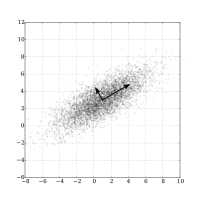
Photo from wikipedia
Abstract 2D Digital Image Correlation (2D DIC) enables full-field in-plane displacement measurement by tracking the physical surface texture in the recorded images. However, because camera magnification is inversely proportional to… Click to show full abstract
Abstract 2D Digital Image Correlation (2D DIC) enables full-field in-plane displacement measurement by tracking the physical surface texture in the recorded images. However, because camera magnification is inversely proportional to object distance, points along the imaged surface can have different scales and appear to move at different rates. Surface curvature and out-of-plane motions may thus lead to perspective errors that manifest as apparent strains, limiting the method suitable only for flat objects that move purely in-plane. Defocused Speckle Imaging (DSI) is a related optical method where the movements of a laser-illuminated surface are determined by tracking the scattered interference speckle pattern. When the camera is in focus, the speckles appear to move at the same rate with the physical surface. However, camera defocus causes the speckle motion to deviate from the actual surface motion. Interestingly, the observed speckle motion magnitude increases with positive defocus distance, which is contrary to the perspective effects inherent to 2D DIC. Remarkably, with optimized geometric arrangement, 2D DIC and DSI have perspective errors that are equal in magnitude but with opposite signs. It is thus possible to compensate perspective errors by performing DIC and DSI measurements simultaneously and simply calculating the average of the two signals. This article derives the proposed compensation principle analytically using simple geometric framework. An experimental demonstration shows that the combination of DIC and DSI reduces magnification-dependent perspective errors by 73%, and errors due to object rigid-body rotation by 86%.
Journal Title: Optics and Lasers in Engineering
Year Published: 2022
Link to full text (if available)
Share on Social Media: Sign Up to like & get
recommendations!